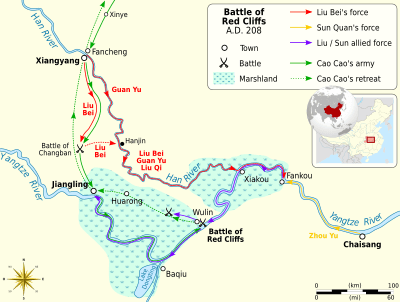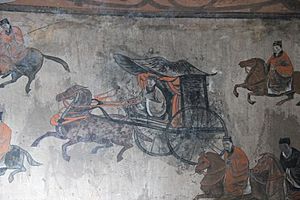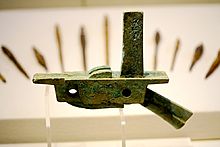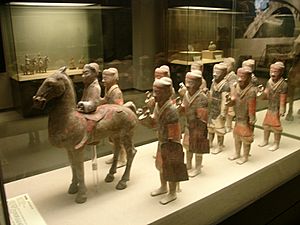Battle of Red Cliffs facts for kids
Quick facts for kids Battle of Red Cliffs |
|||||||||
|---|---|---|---|---|---|---|---|---|---|
| Part of the wars at the end of the Han dynasty | |||||||||
 Engravings on a cliff-side mark one widely accepted site of Chibi, near modern Chibi City, Hubei. The engravings are at least a thousand years old. |
|||||||||
|
|||||||||
| Belligerents | |||||||||
| Sun Quan Liu Bei |
Cao Cao | ||||||||
| Commanders and leaders | |||||||||
| Zhou Yu Cheng Pu Liu Qi |
Cao Cao | ||||||||
| Strength | |||||||||
| 50,000 | 800,000 (Cao Cao's claim) 220,000–240,000 (Zhou Yu's estimate) |
||||||||
| Casualties and losses | |||||||||
| Unknown | Heavy | ||||||||
| Battle of Red Cliffs | |||||||||||||||||
|---|---|---|---|---|---|---|---|---|---|---|---|---|---|---|---|---|---|
| Traditional Chinese | 赤壁之戰 | ||||||||||||||||
| Simplified Chinese | 赤壁之战 | ||||||||||||||||
|
|||||||||||||||||
The Battle of Red Cliffs, also known as the Battle of Chibi, was a very important naval battle. It happened in the winter of 208–209 AD. This battle took place near the end of the Han dynasty in Chinese history. It was about twelve years before the start of the Three Kingdoms period.
The battle was fought between two main groups. On one side were the allied forces of southern warlords Sun Quan and Liu Bei. They were joined by Liu Qi. On the other side was the much larger army of the northern warlord Cao Cao.
Sun Quan and Liu Bei stopped Cao Cao from taking over the lands south of the Yangtze River. This victory meant that Liu Bei and Sun Quan survived. They also gained control of the Yangtze River. This river became a strong defense line. It later helped create the two southern states of Shu Han and Eastern Wu.
Some people call this battle the largest naval battle in history based on the number of people involved. The exact place where the battle happened is still debated. Most experts think it was on the south bank of the Yangtze River. This is southwest of today's Wuhan city.
Contents
What Led to the Battle?
By the year 208, a powerful leader named Cao Cao controlled most of northern China. He had just won a big campaign in 207. This made his northern border safe. Soon after, in the autumn of 208, his army moved south. Cao Cao wanted to quickly defeat his rivals in the south.
Around this time, Liu Biao, a governor in Jing province, died. His son, who took over, quickly gave up to Cao Cao.
Liu Bei was another leader. He was stationed at Fan (modern Xiangfan). When Cao Cao's army approached, Liu Bei quickly fled south. Many people followed him, seeking safety. Cao Cao's fast cavalry chased Liu Bei. They surrounded him at the Battle of Changban. Liu Bei then escaped further east to Xiakou. There, he met with Lu Su, an envoy from Sun Quan.
Liu Bei's main advisor, Zhuge Liang, traveled down the Yangtze River. He went to talk with Sun Quan's state of Wu. Zhuge Liang wanted to form an alliance against Cao Cao. Zhuge Liang's strong arguments and the support of Wu's chief commander, Zhou Yu, convinced Sun Quan. Sun Quan agreed to join forces against Cao Cao. He sent Zhou Yu, Cheng Pu, and Lu Su to help Liu Bei.
Who Fought and How Many?
Cao Cao had captured a key military base called Jiangling. He kept his huge fleet of ships there. The combined forces of Sun Quan and Liu Bei sailed upstream to Red Cliffs. There, they met Cao Cao's first group of soldiers. After a small fight, both sides stopped for a while. Cao Cao set up camp north of the Yangtze River. The allies camped on the south side.
Cao Cao claimed to have 800,000 soldiers. However, Zhou Yu estimated Cao Cao's real strength was around 220,000 to 240,000 men. This number included about 70,000 soldiers from armies Cao Cao had recently defeated. So, many of Cao Cao's troops might not have been very loyal or motivated.
Zhou Yu had about 30,000 marine soldiers. Liu Bei, who had been forced to flee, managed to gather about 20,000 men. So, the allied forces were much smaller than Cao Cao's.
In the famous novel Romance of the Three Kingdoms, Cao Cao boasted about having 1 million men. But even in the novel, his true number was closer to 700,000-800,000 soldiers.
How the Battle Unfolded


The Battle of Red Cliffs happened in a few main parts. First, there was a small fight at Red Cliffs. Then, Cao Cao's forces moved back to the Wulin battlefields. After that, a major naval battle took place. Finally, Cao Cao had a very difficult retreat.
The combined Sun-Liu army sailed upstream to Red Cliffs. There, they met Cao Cao's first group of soldiers. Cao Cao's men were suffering from sickness and low spirits. They had been on long, forced marches. Because of this, they couldn't win the small fight that happened. So, Cao Cao pulled back to Wulin, north of the Yangtze River. The allies also moved back to the south.
Cao Cao had chained his ships together from front to back. He might have done this to help his northern soldiers, who weren't used to being on ships, avoid seasickness. The allied commander, Huang Gai, noticed this. He sent a letter to Cao Cao, pretending to surrender. Huang Gai then prepared a group of ships. These ships were filled with dry reeds, wood, and oil. They were turned into fire ships.
As Huang Gai's "surrendering" ships got close to the middle of the river, the sailors set them on fire. Then, they quickly got into smaller boats. A strong southeastern wind pushed the burning ships towards Cao Cao's fleet. Cao Cao's ships caught fire. Many of his men and horses either burned to death or drowned.
After this surprise attack, Zhou Yu and the allies quickly launched a follow-up attack. Cao Cao's northern army was in total confusion and was completely defeated. Seeing that the situation was hopeless, Cao Cao ordered a full retreat. He destroyed some of his remaining ships before leaving.
Cao Cao's army tried to retreat along Huarong Road. This road included a long part that went through marshlands. Heavy rains had made the road very muddy and dangerous. Many sick soldiers had to carry bundles of grass on their backs. They used the grass to fill the road so the horsemen could cross. Many of these soldiers drowned in the mud or were trampled to death.
The allies, led by Zhou Yu and Liu Bei, chased Cao Cao's forces by land and water. They chased them until they reached Nan Commandery. Along with hunger and disease, this chase greatly reduced Cao Cao's remaining army. Cao Cao then retreated north to his home base. He left some generals to guard important areas.
The allied counterattack might have completely destroyed Cao Cao's forces. However, crossing the Yangtze River became chaotic. The allied armies rushed to the riverbank and fought over the few available ferries. To bring back order, a group led by Sun Quan's general Gan Ning secured a crossing point. Only a strong defense by Cao Ren stopped an even bigger disaster for Cao Cao.
What Happened After the Battle?
By the end of 209, the base Cao Cao had set up at Jiangling fell to Zhou Yu. The land Cao Cao controlled shrank by about 160 kilometers (100 miles). His territory was now mainly around Xiangyang.
Liu Bei gained new land. He took over four areas south of the Yangtze River. These were Wuling, Changsha, Lingling, and Guiyang. Sun Quan's troops had suffered more losses than Liu Bei's. This was due to the long fights against Cao Ren after the Battle of Red Cliffs. Also, Zhou Yu's death in 210 greatly weakened Sun Quan's power in Jing Province.
Liu Bei also took control of Jing Province. Cao Cao had recently lost this area. Jing Province was a very important and naturally protected area on the Yangtze River. Sun Quan had wanted it for himself.
Controlling Jing Province gave Liu Bei easy access to other regions. It opened up important waterways into southeastern China. It also gave him control of the southern Yangtze River. Cao Cao would never again have such a large fleet as he did at Jiangling. He also never got another chance to destroy his southern rivals like this again.
Images for kids
-
Cao Cao surrounded by his generals. From a Peking opera performance.
-
Former Ode on the Red Cliffs, a famous poem by Su Shi from the Song dynasty.
See also
 In Spanish: Batalla de los Acantilados Rojos para niños
In Spanish: Batalla de los Acantilados Rojos para niños





